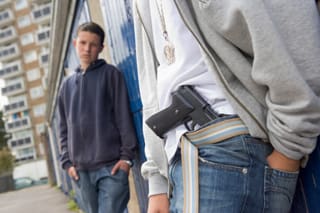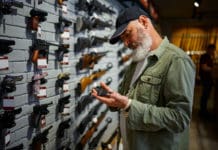Why is the Centers for Disease Control studying firearms? Isn’t that a bit like Glock selling mosquito repellant? And what’s really repellant: Violence-Related Firearm Deaths Among Residents of Metropolitan Areas and Cities — United States, 2006–2007 includes suicides. To call a suicide a “violence-related firearm death” is an obvious and profoundly dishonest ruse designed to inflate absolute numbers and conflate the size and nature of the “target” groups. To wit: “During 2006–2007, a total of 25,423 firearm homicides and 34,235 firearm suicides occurred among U.S. residents.” If you take suicides out of this mix (there are plenty of equally convenient and effective ways to kill yourself) the numbers don’t look anywhere near as daunting. And then there’s whole age issue . . .
Gun control advocates are always harping on about the number of “children” killed by firearms—as if the firearms have a mind of their own. Be that as it clearly isn’t, they argue that if gun control saves the life of even ONE child it’s worth sacrificing the protections afforded by the Second Amendment of the U.S. Constitution. Here’s the CDC’s gun control catnip:
These national totals include 4,166 firearm homicides and 1,446 firearm suicides among youths aged 10–19 years; the rate of firearm homicides among youths slightly exceeded the rate among persons of all ages. This report presents statistics on firearm homicides and firearm suicides for major metropolitan areas and cities, with an emphasis on youths aged 10–19 years in recognition of the importance of early prevention efforts.
Note the use of the word “youths.” The CDC has taken heavy fire for calling this age group “children.” The point being that a good many gang members fall within this age band; it’s hard to argue that gun control will save the life of even ONE gang banger.
Feel free to analyze the numbers and report your finding about the findings below. Suffice it to say, more young people shoot other people and themselves than old people, and they do so more often in urban than rural areas. Something to do with density and drugs one imagines.
But the CDC lacks imagination. As far as they’re concerned, violence intervention efforts are the firearms death inoculation jab our nation needs.
National and state prevention programs directed at reducing firearm violence should focus on youths, particularly in central cities, to reduce the burden of firearm-related mortality in the United States. Initiatives designed to reduce violent deaths in urban areas can draw upon a growing evidence base for effectively addressing behaviors that underlie violence involving youths.
Quick question: who the hell asked them?





Um, is there such a thing as a nonviolent firearms death? Would that be like getting shot by Gandhi?
I see no mention of a firearms training proposal from the CDC.
I wonder how much luck they’ll have.
Have they whipped malaria yet?
If carrying a firearm saves even the life of one child from people who would do that child harm, then it is worth it.
Why are suicides even an issue? I understand the families suffer but these people willfully choose to harm themselves. Ther is no real “victim” the deceased is the killer. A person really determined to take their life does not need a gun.
I may have missed it, but are they including lawful use of firearms by LEOs and private citizens? I wouldn’t put it past them to call such lawful use a homicide.
I believe that’s typically labeled as “lawful intervention”, and where it’s reported is a tiny sliver, about the size of “accidental” and “undetermined”.
“National and state prevention programs directed at reducing firearm violence should focus on youths, particularly in central cities, to reduce the burden of firearm-related mortality in the United States. Initiatives designed to reduce violent deaths in urban areas can draw upon a growing evidence base for effectively addressing behaviors that underlie violence involving youths.”
Remove the word “firearm” from the quote above and it makes perfect sense.
Measures that impact overall violence also – not surprisingly – reduce so-called gun violence as well.
Education, firearms safety, removing the lure of the forbidden/taboo… Better mental health treatments… All of these can and should play a role.
No?
Comments are closed.